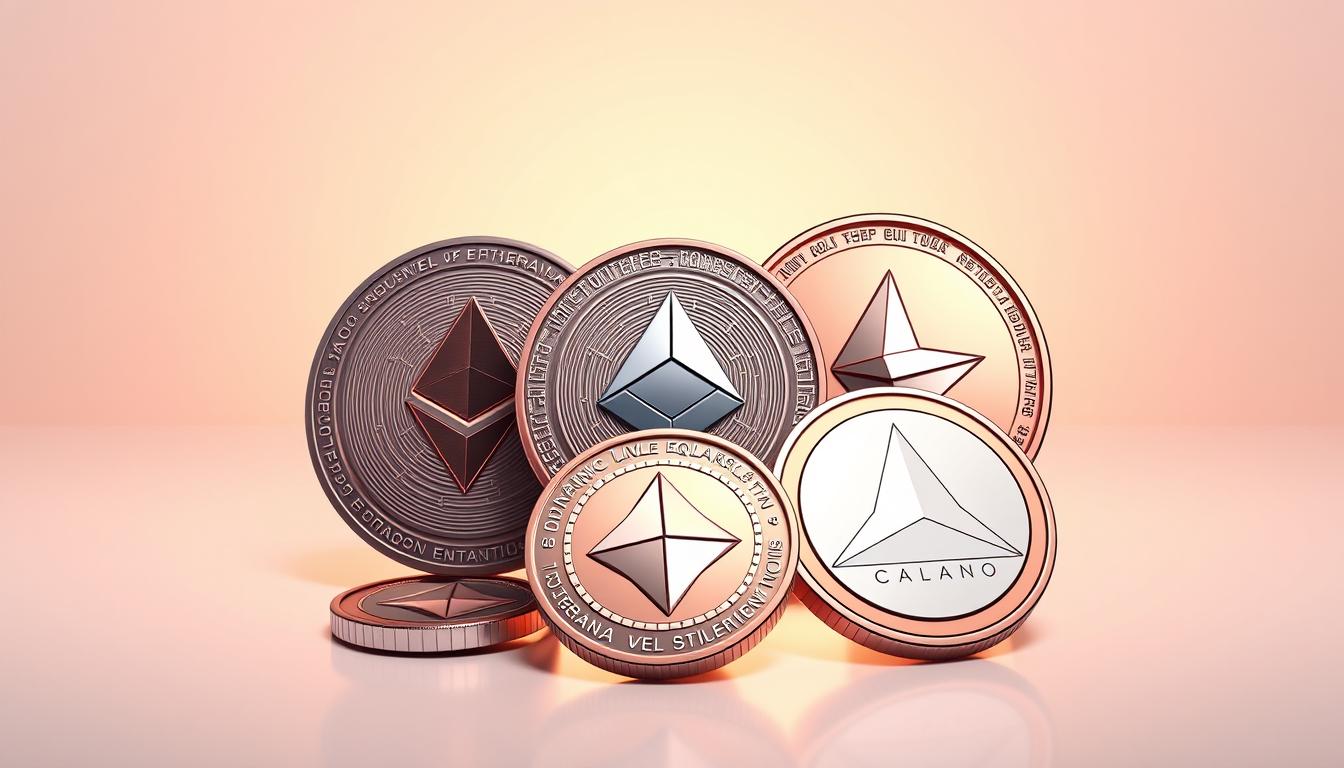Now Reading: Unlock Cross-chain Compatibility: A How-to Guide
- 01
Unlock Cross-chain Compatibility: A How-to Guide
Unlock Cross-chain Compatibility: A How-to Guide

Blockchain technology has changed many industries. But, its true power is hidden when networks don’t talk to each other. Cross-chain compatibility and blockchain interoperability are key to linking these systems. This guide will show you how to make your projects succeed in a world where different chains work together.
If you’re a developer or a business leader, this guide is for you. It makes complex ideas simple. You’ll see how cross-chain compatibility breaks down walls between networks like Ethereum, Solana, and Avalanche. This opens doors to new ideas and growth.
Key Takeaways
- Discover core principles of cross-chain compatibility and interoperability
- Explore real-world applications driving industry adoption
- Understand technical requirements for secure bridge implementations
- Learn how major protocols enable multi-chain ecosystems
- Gain strategies to mitigate risks in cross-chain transactions
Understanding Cross-chain Compatibility in Today’s Blockchain Landscape
Blockchain technology is growing fast, with Bitcoin and Ethereum leading the way. Now, blockchain interoperability is changing how these systems work together. It makes it easier for them to share resources and collaborate.
The Evolution of Blockchain Networks
At first, blockchains worked alone. Bitcoin started with decentralized transactions, and Ethereum added smart contracts. Later, Solana and Cardano made things faster and more efficient. But, these improvements were mostly for their own systems, not for working together.
Why Isolated Blockchains Are Limiting Innovation
Being separate holds back progress. For example, Ethereum’s DeFi can’t easily use Solana’s resources. This makes things harder for users. Without cross-chain compatibility, developers have to start over for each blockchain, slowing things down.
The Rise of Multi-chain Ecosystems
Now, projects focus on multi-chain ecosystems. Polkadot and Cosmos are leading the way with new ways to share resources. This lets users move assets and use apps across different blockchains. It helps everyone work together better and reach more people.
The Technical Foundations of Blockchain Interoperability
Blockchain interoperability is built on key technologies. These allow different networks to talk to each other. They use special tools and systems to link isolated blockchains, making a single ecosystem.
Important innovations include atomic swaps, HTLCs, and special protocols. These help blockchains work together smoothly.
- Atomic swaps let users move assets directly between chains without needing a middleman. These exchanges happen directly between users, ensuring funds are only moved when both sides agree.
- Hash time-locked contracts (HTLCs) add security. They make sure transactions happen only when certain conditions are met, stopping fraud.
- Oracles act as data bridges. They bring real-world data into smart contracts, triggering actions like decentralized swaps.
Relay chains and sidechains act as middlemen. They help keep networks in sync. Systems like Polkadot’s shared security model or Cosmos’s IBC standardize data exchange between blockchains.
Consensus mechanisms are crucial. They make sure all participants agree on transaction validity. This is key for cross-chain events to happen smoothly.
These technical layers are the heart of multi-chain systems. They support everything from DeFi swaps to app coordination. Understanding these basics is vital for developers working on interoperable solutions.
Key Benefits of Implementing Cross-chain Solutions
Using cross-chain compatibility brings big wins for businesses and users in blockchain. It lets projects tap into new chances and fix old problems of being stuck in one network.

Enhanced Liquidity Across Networks
Assets can now move between networks easily. Cross-chain bridges help users swap tokens, growing liquidity and fixing price gaps. For instance, stablecoins like USDT flow smoothly between Ethereum and Solana, making markets deeper and prices more accurate.
Reduced Transaction Costs and Friction
Users save on fees by using cheaper networks. Smart contracts can run on low-cost chains like BNB Smart Chain instead of Ethereum. This cuts down on costs without losing security.
Expanded Use Case Possibilities
Developers create apps that use the best of different chains. Decentralized exchanges like interoperable blockchain solutions offer hybrid DeFi products. NFTs can move between ecosystems for wider use. New services appear where one chain couldn’t handle them.
Risk Mitigation Through Diversification
Not relying on one network’s security or rules is key. Systems like payment processors can send transactions on various chains. If one blockchain has issues, others keep working, lowering overall risk.
Popular Cross-chain Compatibility Protocols Worth Exploring
Developers looking to create cross-chain apps have many interoperability protocols to choose from. These tools make blockchain integration easier. They help move data and assets smoothly between different networks. Here are four key protocols leading the way in multi-chain technology:
Polkadot and the Parachain Model
Polkadot links specialized parachain blockchains to a main relay chain. This setup lets each blockchain share security while keeping its own features. It’s great for projects like DeFi platforms or NFT marketplaces because it lowers risks.
Cosmos and the Inter-Blockchain Communication Protocol
Cosmos’s IBC protocol lets blockchains share data freely. It uses a hub-and-spoke model. This way, networks like Osmosis can work with other Cosmos chains, growing their liquidity and functions.
Chainlink and Cross-Chain Interoperability Network (CCIP)
Chainlink’s CCIP goes beyond oracles to support cross-chain transactions. It connects Ethereum, Solana, and more, making interoperability protocols better for DeFi apps. These apps need real-time data from various networks.
THORChain and Cross-Chain Liquidity
THORChain’s Continuous Liquidity Pools (CLP) make atomic swaps between blockchains like Bitcoin and Ethereum possible. Its decentralized model cuts out middlemen. This makes it a top pick for safe, direct cross-chain swaps without centralized exchanges.
How Cross-chain Bridges Function as Interoperability Solutions
Cross-chain transactions rely on blockchain interoperability tools called bridges. These systems connect different networks, allowing assets and data to move between them. Bridges act as middlemen, making sure protocols work across isolated ledgers.
Bridges are mainly of three types: trusted, trustless, and hybrid. Trusted bridges use central custodians to hold assets during transfers. Trustless options use smart contracts for automated transfers, needing less human oversight. Hybrid models offer a mix of both, balancing security and speed.
The technical setup varies but often includes validator networks and relayers. Smart contracts handle the rules, like locking assets on one chain while creating new ones on another. For instance, Wormhole uses guardians for transfers, while Axelar uses message relays for cross-chain talks.
- Trusted bridges focus on control but risk centralization
- Trustless bridges aim for decentralization but may face technical limits
- Hybrid models mix both to solve trade-offs
Security is key. Bridges often use multi-signature wallets or oracles to confirm transactions. Yet, risks like the 2022 Wormhole exploit show vulnerabilities. Developers must check protocols and watch for fraud to safeguard cross-chain transactions.
Protocols like Multichain and Connext show different approaches. Multichain uses liquidity pools for swaps, while Connext employs “wormhole” tunnels for fast transfers. The right bridge choice depends on project goals, speed needs, and security concerns.
Building Your First Cross-chain Application: A Step-by-Step Guide
Creating cross-chain apps needs a clear plan for cross-chain compatibility. Begin by setting up your workspace with tools for interoperable blockchain solutions. This guide will help you take it one step at a time.

Setting Up Your Development Environment
Choose an IDE like Remix IDE or VS Code with blockchain extensions. Install SDKs like Web3.js or ethers.js for Ethereum projects. Use test networks like Ropsten or Polygon Mumbai for cross-chain tests without real money.
- Install blockchain development kits (SDKs) for target networks
- Set up test wallets and API keys for simulation
- Configure node modules for multi-chain communication
Selecting Compatible Blockchain Networks
Look for networks with good interoperable blockchain solutions. Focus on ecosystems like Polkadot or Cosmos that support cross-chain messaging. Make sure there’s a bridge between the chains for easy asset transfers.
Implementing Cross-chain Communication Logic
Write smart contracts using modular patterns. For instance, create a “lock-and-mint” system. This freezes assets on one chain and mints them on another:
function crossChainTransfer(address recipient, uint256 amount) public {
// Lock assets on origin chain
// Trigger mint on destination chain via bridge
}
Testing and Troubleshooting Common Issues
Use Hardhat or Truffle for unit tests to check cross-chain workflows. Watch out for gas limit errors, failed state syncs, or bridge delays. Blockchain explorers help trace transactions and fix issues.
Begin with testnet deployments and then move to live networks. Document each step to improve your cross-chain compatibility skills.
Security Considerations When Implementing Cross-chain Transactions
Secure cross-chain transactions need strong blockchain integration. Developers must focus on defense-in-depth strategies. This helps reduce risks in multi-chain systems.
- Attack vectors: Cross-chain bridges face threats like relay hijacking. Malicious actors can manipulate message relays between networks. Replay attacks targeting blockchain integration protocols have caused millions in losses, as seen in the Axie Infinity Ronin Bridge exploit. Consensus failures in hybrid systems can also enable validator collusion.
- Best practices: Implement strict timeout parameters for pending cross-chain transactions. Use multi-signature custodial wallets for liquidity pools. Deploy oracles to verify on-chain events across networks. Monitor transaction hashes in real-time using tools like Chainalysis.
- Audit requirements: Third-party audits must validate cross-chain smart contracts, bridge logic, and consensus mechanisms. Auditors should have blockchain integration expertise, with certifications from organizations like ConsenSys Diligence or Certik. Formal verification tools like MythX are essential for critical components.
Proper blockchain integration demands continuous threat modeling. Regular stress tests simulating 51% attacks on connected chains help identify weaknesses. Transparent documentation of security parameters ensures stakeholders understand risks associated with cross-chain transactions.
Decentralized Networks and Their Approach to Interoperability
Decentralized networks focus on freedom and blockchain interoperability. They aim to keep things secure and open. For instance, Ethereum uses Polygon for faster transactions while keeping its core safe.
Bitcoin connects to other networks through tokens like tBTC. This way, it keeps things transparent and secure.
- Ethereum: Works on scaling with cross-chain messaging for Ethereum 2.0, adding sharding and relays.
- Polkadot: Allows different blockchains to share data through parachains, keeping things decentralized.
- THORChain: Has a decentralized pool for liquidity, avoiding central control.
Governance is key. Decisions on new chains or upgrades often need community votes. In Cosmos, token holders decide on IBC partnerships, keeping things fair.
Security is a big deal. Using privacy tech builds trust. But, scaling without losing decentralization is hard. Still, progress hints at a future where decentralized networks work together without losing their freedom.
Cross-chain Communication: Protocols and Standards
Interoperability protocols are key to cross-chain communication. They let blockchains share data easily. These systems use technical frameworks for secure and efficient interactions.

- Message Passing Methods: Relay nodes, light clients, and zero-knowledge (ZK) proofs handle data transfers. Relays validate transactions, light clients verify block headers, and ZK proofs confirm validity without exposing private details.
- State Synchronization: Techniques like state proofs, fraud proofs, and validity proofs ensure all networks share accurate data. These mechanisms prevent discrepancies and maintain trust between chains.
- Emerging Standards: Protocols like Chainlink’s CCIP and Cosmos’s IBC set rules for message formats and security checks. These frameworks aim to become industry norms, simplifying how developers build multi-chain apps.
Developers must consider security, speed, and community adoption when choosing protocols. Standards like CCIP and IBC are becoming popular. They offer tested solutions for cross-chain communication. As more projects use these tools, interoperability will boost innovation in DeFi, NFTs, and enterprise systems.
Real-world Use Cases of Successful Blockchain Integration
Decentralized finance (DeFi) protocols have led the way in blockchain integration. They’ve made it easier for users to access and use funds. Aave, Curve, and Yearn Finance have expanded to Ethereum, Solana, and Avalanche. This has allowed users to borrow, swap, and farm yields across different chains.
This approach has greatly increased Aave’s total value locked (TVL) by 300% in 2023. It has done so by tapping into multiple networks.
Enterprise adoption shows the real-world value of blockchain. JPMorgan’s Onyx platform uses cross-chain payments. It settles transactions between Ethereum and Stellar, reducing times from days to minutes.
Walmart’s supply chain system now tracks produce using a hybrid Hyperledger and Corda network. This ensures food safety and compliance across borders.
- DeFi Expansion: Yearn’s yield aggregator pools assets from 8+ chains, optimizing returns for users.
- Enterprise Solutions: Pharmaceutical firms like Pfizer use cross-chain smart contracts to verify drug authenticity from production to pharmacies.
- Gaming Innovation: The Sandbox enables players to trade NFTs between Ethereum and Flow, boosting its user base by 45% in 2023.
Gaming and NFT platforms use cross-chain bridges to grow their audiences. Axie Infinity’s Ronin sidechain interoperability with Ethereum reduced gas fees by 90%. This made daily play-to-earn accessible worldwide.
Enjin’s cross-chain NFTs allow collectors to move digital assets between Binance Smart Chain and Ethereum. This shows multi-chain ecosystems drive user adoption.
Overcoming Common Challenges in Cross-chain Projects
Creating cross-chain compatibility solutions faces many hurdles. A TreasuryXL analysis points out these challenges. But, there are practical ways to overcome them. Let’s look at some effective solutions for each challenge.
- Technical Challenges
- Finality Time Mismatches: Use middleware to bridge the gap in consensus times between networks like Ethereum and Solana.
- Nonce Synchronization: Adopt protocols like Polkadot’s XCM to align transaction sequences.
- Chain Reorganizations: Employ fault-tolerant systems to handle blockchain forks without halting operations.
- Operational Challenges
- Node Infrastructure: Automate deployments using Terraform to manage nodes across multiple chains.
- Transaction Monitoring: Tools like Chainalysis track cross-chain activity in real time.
- Disaster Recovery: Regular simulations and backup systems minimize downtime during outages.
- Business Challenges
- User Experience: Simplify interfaces to hide the complexity of blockchain integration from end-users.
- Fee Models: Implement tiered pricing based on transaction size and network congestion.
- Protocol Upgrades: Use version control systems like Git to coordinate simultaneous updates across chains.
Proven solutions like THORChain’s liquidity pools and Polkadot’s parachain model show innovation can overcome obstacles. Focus on iterative testing and community collaboration to build strong cross-chain systems.
The Economics of Cross-chain Transactions: Fee Structures and Incentives
The economics of cross-chain transactions depends on fees and incentives. These help balance security and user adoption. Interoperability protocols must manage costs and ensure validators act honestly. Let’s explore the key components of this ecosystem.
Gas fees on individual blockchains and bridge fees from interoperability protocols are key. For example, sending tokens from Ethereum to BSC via a bridge includes fees from Ethereum, the bridge, and the destination chain. Protocols like THORChain charge fees based on transaction size. Others, like Cosmos, separate base fees from network congestion costs. These structures affect user costs and adoption rates.

Validators earn rewards through staking and fee sharing. In Polkadot, validators stake DOT tokens to relay messages between chains. Misconduct can lead to slashing penalties, where staked funds are seized. Protocols like Chainlink’s CCIP reward relayers with a share of transaction fees, encouraging honest data submission. These systems use economic carrots and sticks to ensure security.- Staking: Required to participate, with rewards for uptime
- Rewards: Earned via transaction fees or protocol token distributions
- Slashing: Penalties for dishonest behavior, such as double-signing
Optimistic models like those in Polkadot’s XCMP assume validity but allow fraud proofs. Users can challenge suspicious transactions within a challenge period. In contrast, upfront proof systems like THORChain’s bonded liquidity require validators to post collateral before processing swaps. These models balance capital efficiency with security guarantees. Protocols must choose between faster throughput or higher upfront costs based on their use case.
Understanding these mechanics helps developers choose protocols that match economic incentives with project goals. Balancing fees, validator rewards, and security models ensures systems stay secure and user-friendly.
Tools and Resources for Testing Interoperable Blockchain Solutions
Testing frameworks are key for checking interoperable blockchain solutions. Developers use tools to test how different blockchains work together before they go live. Here are some top resources for testing:
- Hardhat: It has plugins for testing smart contracts across chains. You can set up networks like Ethereum and Polygon together.
- Foundry: It has modules for testing state changes between different protocols.
- Polkadot’s Rococo: It’s a public testnet for Polkadot. You can test parachain messages and asset transfers without using real money.
Tools like Chainalysis or Blockscout help track transactions across networks. Debuggers like Truffle’s cross-chain tracing show where relay steps fail. For more detailed checks:
- Simulation tools: Cosmos’ Gaia testnet mimics delays in inter-blockchain messages.
- Fuzz testing: OpenZeppelin’s Slither tests cross-chain logic for unusual cases.
Testnet resources include Alchemy’s faucet for test tokens and Chainlink’s bridge setups. Public testnets like Cosmos’ and THORChain’s ThorNode test environments help lower risks. Always check asset transfers and message relays through these networks to make sure blockchain interoperability works well.
Regulatory Considerations for Cross-chain Applications
As cross-chain technology grows, so do regulatory challenges. Projects on decentralized networks must meet compliance rules that differ worldwide. This section looks at how laws shape cross-chain innovation.
Compliance Challenges Across Different Jurisdictions
Operators face different rules in big markets:
- US: SEC guidelines on token classification impact cross-chain DeFi apps
- EU: MiCA regulation mandates licensing for crypto asset service providers
- Asia: Singapore’s MAS and Japan’s FSA enforce strict custody requirements
KYC/AML Requirements for Cross-chain Services
Compliance must cover all connected networks. Key duties include:
- Travel Rule reporting for transfers exceeding $1,000
- Real-time transaction monitoring across all connected blockchains
- Centralized KYC portals for multi-chain user verification
Navigating the Evolving Regulatory Landscape
New rules like the EU’s MiCA and updated FATF guidelines need proactive plans:
- Adopt jurisdictional diversification to avoid single-market dependency
- Implement automated compliance tools for real-time regulatory checks
- Engage legal experts specializing in cross-border crypto regulations
Proactive compliance frameworks are key for cross-chain projects. Balancing cross-chain compatibility with regulatory demands requires constant monitoring of global policies. Decentralized networks must add compliance layers without blocking innovation.
Embracing the Multi-chain Future: How to Position Your Project for Maximum Interoperability
Developers need to focus on modular design to make projects ready for the future. Creating systems that work on any chain helps them grow with new tech. This way, projects stay flexible and keep their main features working well everywhere.
It’s important to have good plans for updating protocols on different chains. Getting input from the blockchain community helps make sure everyone is on the same page. Using tools like Polkadot’s parachain model helps build trust and teamwork between networks.
Choosing the right tools for talking between chains, like Cosmos’s IBC, makes things easier. Frameworks like THORChain’s liquidity pools are safe ways to move assets. Picking scalable solutions helps projects grow in areas like decentralized finance and NFTs.
Business plans should start with big chains like Ethereum or Solana. Then, move to smaller markets. Roadmaps should show how to add new networks step by step. Building a community in every ecosystem helps get more people involved.
Looking ahead, new tech like zero-knowledge proofs will change how we connect chains. Teams should keep up with these advancements. By using these technologies early, projects can be leaders in a world where easy cross-chain talk is key.
FAQ
What is cross-chain compatibility in blockchain technology?
Cross-chain compatibility lets different blockchains talk to each other. This makes it possible for assets and data to move between networks. It’s key for making blockchains work together, improving liquidity, and driving innovation.
Why is cross-chain interoperability important?
It’s important because it connects isolated blockchains. This leads to more innovation, teamwork, and better blockchain solutions. It also helps users use different blockchains’ strengths, cuts costs, and lowers risks.
What are some common techniques used for achieving blockchain interoperability?
Techniques include atomic swaps, sidechains, relay chains, and oracles. Also, standards like Inter-Blockchain Communication (IBC) and Cross-Chain Interoperability Protocol (CCIP) help blockchains talk to each other.
What are the benefits of implementing cross-chain solutions?
Cross-chain solutions bring many benefits. They improve liquidity, lower costs, open up new use cases, and reduce risks. These benefits make the blockchain ecosystem stronger and more flexible.
How do cross-chain bridges work?
Cross-chain bridges move assets and data between blockchains. They can be trusted or trustless, using different methods like validator networks. Wormhole and Axelar are examples of major implementations.
What should I consider when developing a cross-chain application?
When making a cross-chain app, choose the right blockchain networks and set up a compatible environment. Make sure your app can securely talk to other chains and test it well. This ensures it works across different ecosystems.
What security considerations should be taken into account for cross-chain transactions?
Security is key. Look out for common attacks, keep bridges secure, and audit apps thoroughly. This protects against threats like relay manipulation and replay attacks.
What role do decentralized networks play in cross-chain interoperability?
Decentralized networks focus on speed, security, and decentralization. They aim for trustless interactions and involve token holders in important decisions. This ensures interoperability is balanced and secure.
What are some real-world use cases of cross-chain applications?
Use cases include DeFi apps on multiple chains, enterprise data sharing, and gaming platforms. These examples show how blockchain integration adds value across sectors.
How do cross-chain transactions impact fees and economics?
Fees vary by blockchain and are influenced by bridge costs and gas. Understanding economic models and validator incentives is key for cost optimization and system sustainability.
What tools are available for testing cross-chain applications?
Tools include Hardhat for simulations, protocol-specific testnets, and monitoring tools. These help debug and simulate cross-chain interactions effectively.
What regulatory considerations are essential for cross-chain applications?
Considerations include following different laws, KYC/AML rules, and the changing regulatory landscape. Staying compliant is crucial for project success and user trust.













